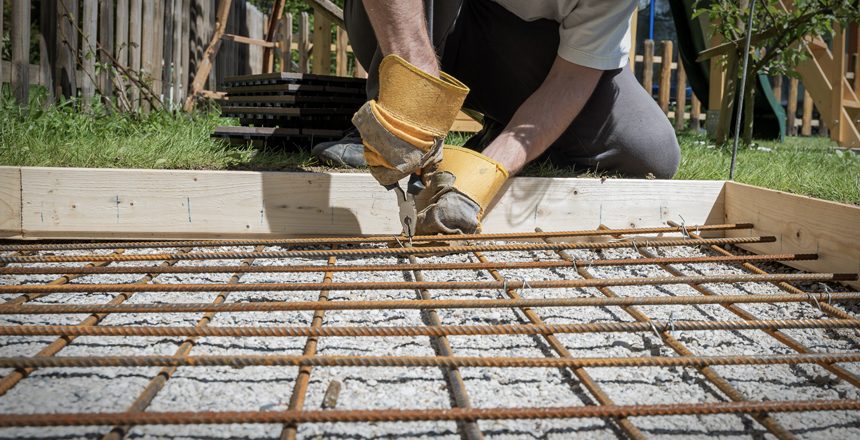Considering a concrete project to boost your home value? It’s an excellent way to improve your property, but concrete is more than just framing and pouring. It’s important to use rebar in concrete projects, even when it doesn’t seem like a major undertaking.
Why Should You Use Rebar in Concrete Projects?
Concrete is an essential material in construction. Its durability is unmatched because it handles pressure extremely well. When it comes to stress that involves compression or being pushed together—also known as compressive stress—concrete is a champ.
However, when it comes to tension or pulling—also known as tensile stress—concrete does not hold up very well. The tensile strength of concrete is as much as eight times worse than the compressive strength. This means concrete is extremely brittle and can break quickly when it experiences any kind of tensile stress.
That’s where rebar in concrete projects helps out. Rebar handles tensile stress extremely well. When combined, the concrete and rebar have extreme compressive AND tensile strength, making it a very powerful building material.
While not always necessary, in our experience, you can count on most concrete projects benefiting from some type of rebar. Keep reading to learn when you should use rebar and what type of rebar you should use.
What Is Rebar?
Rebar is short for “reinforced bar.” It is typically made from steel and has bumps or ridges along its surface. These ridges increase the ability of concrete to bond with the steel. Combined, rebar and concrete create a composite material that can double the strength of concrete on its own.
Concrete rebar has been used in concrete construction since at least the 15th century. Its application and design have been developed over centuries to create the extremely effective rebar we use today.
What Are The Benefits Of Using Rebar in Concrete DIY Projects?
Here are some of the main uses of concrete rebar:
- Primary reinforcement: This is when rebar is used to ensure a structure has the resistance to hold the weight of its own design.
- Secondary reinforcement: As concrete expands and contracts with temperature changes, tiny cracks form (it’s inevitable). Rebar, in most cases, helps hold cracks together.
- Distribute weight: Rebar can be used to distribute the weight of a load across a wider concrete surface.
- Load assistance: Rebar can be used within other steel bars and beams to assist with the load they carry for the structure’s design.
- External use: In some circumstances, rebar will be used outside of concrete to reinforce the structure.
When using rebar in concrete projects, you can expect significantly fewer cracks in the concrete over time.
While unreinforced concrete will break without warning, rebar reinforced concrete will display signs of stress before breaking. This is significant because it gives time for work to be done on a foundation or other concrete structure before serious damage occurs.
What Are The Different Types of Rebar?
Rebar varies in yield strength, ultimate tensile strength, chemical composition, and percentage of elongation. Choosing what type of rebar to use will depend on the type and location of the concrete structure. Is it vertical or horizontal? How much weight will it be carrying? Will it be in contact with wind or water? These are all things to consider when choosing your rebar.
Here are the main types of concrete rebar:
- Carbon Steel Rebar: Also known as “black bar,” carbon steel rebar is the most common type of rebar. It is an excellent go-to, but it does not handle corrosion well, making it less than ideal for projects where it will encounter water or moisture.
- Epoxy-Coated Rebar: As the name suggests, this rebar has a thin coat of epoxy which makes it 1,700 times more resistant to corrosion than carbon steel rebar. It is ideal for projects that encounter saltwater or where corrosion is imminent.
- One thing to note is that the coating is extremely fragile so epoxy-coated rebar should be ordered from a reputable supplier to avoid damaged or low-quality application.
- Galvanized Rebar: Galvanized rebar is kind of the happy medium between carbon steel and epoxy-coated rebar. Galvanized rebar is only 40 times more resistant to corrosion than carbon steel rebar, but much harder to damage than epoxy-coated rebar.
- One downside is that it is almost 40% more expensive than epoxy-coated rebar.
- European Rebar: The primary benefit of European Rebar is the low price. It is made out of manganese, which is cheap and easy to bend. It lacks some of the strength and durability of other rebars, but can be a good option for the right project.
- Should not be used in areas that experience earthquakes or for structures that need substantial structural integrity.
- Stainless Steel Rebar: If you want to pay for it, stainless steel rebar is the best option for most projects. It is 1,500 times more resistant to corrosion than carbon steel rebar and can easily be bent and cut in the field. However, for the cost, it may be overkill to add this super-strength rebar in concrete projects that don’t really need it.
- Glass-Fiber-Reinforced-Polymer (GFRP) Rebar: If corrosion is your concern, GFRP might be the right choice. It will never corrode under any circumstances. You’ll pay for it though, as it can run 10 times more expensive than epoxy-coated rebar.
- Welded Wire Fabric: Basically a net of steel wires electrically welded at right angles, welded wire fabric (WWF) is most often used for horizontal slabs of concrete like flooring. Thicker versions can be used in walls, pavement, and other structures.
- Sheet-Metal Reinforcing Bars: Commonly used in floors and slab concrete, this is annealed sheet metal bent into grooves about 1/16th inch deep and set with holes at regular intervals.
Rebars can range in size from 0.05 inches to 4.00 inches. Obviously, a larger size of rebar will be able to handle larger amounts of stress and vice-versa.
When Do I Need To Use Rebar?
Using rebar in concrete projects on smaller scales may not be necessary. If you’re pouring concrete for your driveway, and you’ll probably never put something heavier than the family minivan on it, rebar might seem like overkill. Instead, you might opt for a cheaper option, like welded wire fabric. It isn’t as strong as other rebars, but provides a similar benefit to a smaller degree.
When pouring concrete for surfaces that hold extreme weight—like heavy machinery and buildings—or surfaces that experience steady or repeated traffic, you should definitely include rebar. Vertical concrete structures, like a wall, should also always have rebar.
How Do You Work With Rebar?
While professionals like us have all the tools on hand to make a concrete project quick and easy, you won’t always have those resources for a DIY concrete project. When you purchase rebar, it may not be the shape and length that you need. You should be prepared to cut and bend it as the project requires.
For thin rebars, you can use a hacksaw or bolt cutter without too much trouble. Projects that will have you cutting a lot of rebar will go much smoother if you get an angle cutter.
Manually bending rebar can be a difficult and even dangerous process. If you plan to bend rebar by hand, always use protective equipment such as eye protection and gloves. Do it in a wide-open space. Choose reasonably thin rebar. A 1/4 inch is a safe bet. (For thicker rebar, you will probably want to look into purchasing a rebar bender.)
The most effective technique is to put the rebar in a vise to hold it in place and use a steel bar on the free end to create leverage for bending.
You should not heat the rebar in order to bend it. This should only be done in very specific circumstances and requires a professional.
Never hit or smack the rebar with a hammer or other device in order to bend it. It gives you little control over the final shape, and it can cause the rebar to weaken and break further down the line.
For very thick rebar in concrete projects, or projects where you will be bending a lot of rebar, you should invest in a power bender.
Do Your Rebar Research!
Doing your own concrete construction is a great way to save money and learn a few new skills. However, it’s important to go into your project fully aware. The correct placement of rebar in concrete projects is extremely important. If spacing is changed even 1 inch, the concrete can lose as much as 20% of its strength.
Brooks Construction has been in the concrete business since 1946. So if you decide you need help, reach out or give us a call at 605-368-5447!



